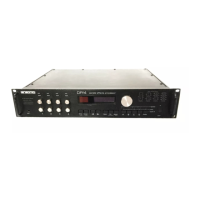Section 2 — Algorithms
ENSONIQ DP/4+ Reference Manual 103
VOCODER
The DP/4+ features a vocoder. A vocoder analyzes the frequency spectrum from an incoming
source (most commonly speech from a microphone) and applies that analysis to the pitched
sounds from the output of another source (like a synthesizer).
DP/4+ Output
DP/4+ sees
Input 1 (vox)
Input 2 (carrier)
and applies it
to the carrier
Audio Out
☞ Important: The vocoder, though made up of four 1-Unit algorithms, is only made available
in the DP/4+ as a Config Preset . There are two different vocoder config presets in the
DP/4+ (Config ROM Presets #61 and 62). Don’t go looking for the four 1-Unit algorithms
that make up the vocoder in the list of 1-Unit Presets -- they are not there. If you accidentally
change 1-Unit presets when editing the vocoder, press {CANCEL"NO} to abort the edit.
How the Vocoder Works
In the DP/4+, the vocoder uses all four units to perform one function. The four algorithms that
make up the vocoder each cover a different frequency band. They are connected in parallel so
that they all receive the same two inputs. The vocoder algorithms analyze the incoming signal
(Input 1) and apply it to another source (Input 2). The vocoder config preset joins the four
different algorithms (Vocoder Low, Vocoder Mid1, Vocoder Mid2, and Vocoder High) which
work together to create the vocoder effect.
Sibilance
Extractor
Spectrum
Analyzer
Real Time Dynamic
Multi-band EQ
Input 1
(vox)
Input 2
(carrier)
Vocoded
Output
The incoming voice signal (vox), connected to Input 1, is sent to the Spectrum Analyzer. The
bandpass filters within the Analyzer divide the voice signal into separate frequency bands. The
Analyzer then measures the signal level in each of these bands and supplies this information to
the Real Time Dynamic Multi-band EQ. This EQ section divides the carrier signal (Input 2) into
separate frequency bands. The output level of each of these bands is controlled by the signal
level measured in the corresponding band of the analyzer. The result is that the frequency
spectrum of the Carrier signal is forced to match the spectrum of the Vox signal. There is also an
internal signal from the Vox input that bypasses the spectrum analyzer and sends the high-
frequency sibilance sounds (t’s, p’s, clicks, pops, etc.) directly to the output for improved
articulation.

